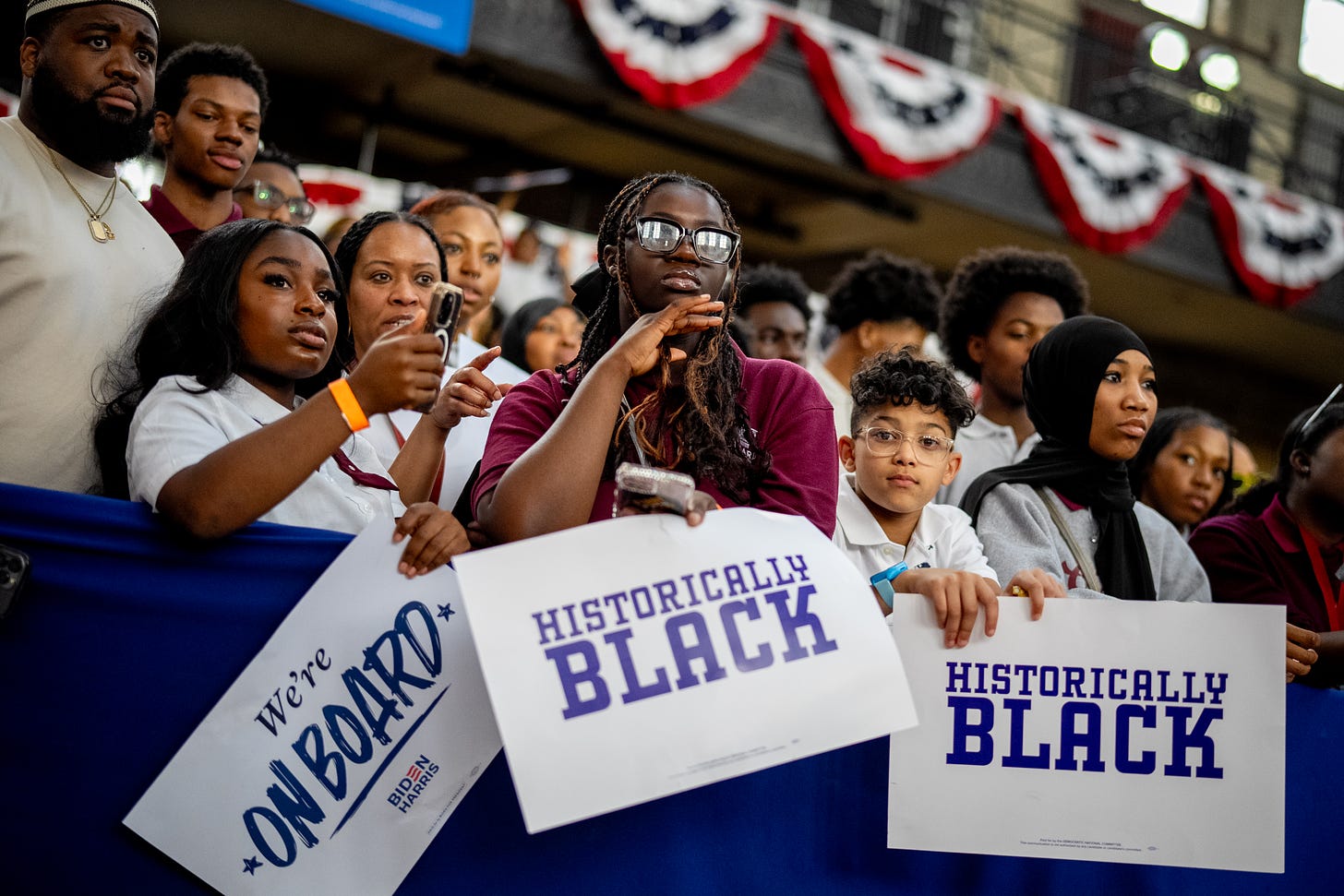Dem Groups Hit the Alarm Button Over Black Voter Outreach
A new memo paints a bleak picture about efforts to win black voters in battleground states.

EARLIER THIS WEEK, two national Democratic groups released a memo warning that efforts to turn out voters of color were being severely underfunded.
That warning, issued by the Democratic super PAC Priorities USA and the progressive advocacy organization ProgressNow, was based on two sets of data. The first was a polling analysis showing that black, latino, and young voters in key swing states were not supporting Kamala Harris at the same levels as they had supported Joe Biden in 2020. The second was ad spending data showing that since the start of August, just 15 percent of digital communications on behalf of Harris had targeted communities of color in those states.
It was an alarm bell.
It also may have undersold the problem.
Since that data was compiled, officials at Priorities USA have put together another analysis. This time, they looked at the digital communications targeting just black voters by counting dollars spent by black voter groups, tracking ads that specifically mentioned black voters, and focusing on online ads run in zip codes and counties with the highest concentrations of black voters.
The analysis revealed that from September 7 through September 21, an estimated 1 percent of all digital ad spending had been specifically directed at black voters in battleground states. When looking only at at ads on Google platforms, where the targeting data is most accurate, the number went up only marginally to about 2.5 percent.
Leaders at Priorities USA and ProgressNow fear that such levels of expenditures could prove politically fatal.
“We are nowhere near where we need to be when it comes to investing in voters of color online. We hope this alarm bell encourages donors to invest with organizations that have well laid plans and deep expertise at reaching black voters,” said Danielle Butterfield, executive director of Priorities USA.
The decision by Priorities and ProgressNow to release their findings has caused tensions within the Democratic party, with some operatives questioning not just the value of publicly airing such concerns so close to the election but whether the analysis tells a complete story.
Both the Harris campaign and its main allied super PAC, Future Forward, are keenly aware of the necessity in turning out black voters. They also have spent tens of millions of dollars on digital communications toward that end. But they have focused more on major platforms with bigger, broader audiences (that include black voters) rather than on micro-targeting specific constituencies.
One Future Forward official noted that the group’s summer ad buy (digital and TV) was over-indexed among black voters and latino voters, with targeted programs including Family Feud, Divorce Court, Hot Bench, TMZ, BET, OWN, VH1, Tamron Hall, Entertainment Tonight, Dr Phil, the Bounce Network, and both college football and the NFL. They also were spending heavily on YouTube, where a massive share of the voting audience—especially young black voters—are now getting their news. Those ads wouldn’t necessarily show up in Priorities USA’s analysis. But Black voters would be reached.
While there may be tactical disagreements over how to best reach black voters, all sides of the debate recognize the damage that could come through a failure to engage this group. Donald Trump has made inroads already with this constituency and his team has been particularly invested in trying to turn out young black men.
According to projections by Priorities USA, Harris would need roughly 42 percent of all her voters in Georgia to be black if she were to get 50 percent of the vote in that state. That number is 26 percent in North Carolina, 13 percent in Michigan, 11 percent in Pennsylvania, 9 percent in Nevada, and 4 percent in both Wisconsin and Arizona.
Compounding matters is that Harris, despite having served as vice president for nearly four years, only recently became the party’s presidential nominee.
“Atmospherically, I would say, it is important to remember, this is the shortest ever general election between two candidates,” said Anna Scholl, executive director of ProgressNow. “It’s a 100-day sprint. And Vice President Harris is just not as well known as Donald Trump or President Biden and has a short runway to introduce herself to these voters.”
Attempts to get more attention on this problem have persisted for months. But they’ve accelerated as the election has neared. Earlier in September, the Harris campaign chair Jen O’Malley Dillon circulated a memo formally blessing thirteen independent groups for Democratic donors to support. Among them, as the Washington Post reported, were “BlackPAC, which targets African American voters; Somos Votantes, which targets Latinos; AAPI Victory, which targets Asian voters.” The list also included Priorities USA, which according to the latest FEC report had spent roughly $4.8 million this cycle, with another $2.5 million on hand—well short of its more ambitious goals.
Within the party, the O’Malley Dillon memo was interpreted as a signal that the campaign wanted more dollars sent to groups that would do the type of microtargetting of individual constituencies that Priorities USA was encouraging. But among those groups, a difference has yet to be detected.
“Every cycle we are waiting until the end to get money,” said Rashad Robinson, the president of Color of Change. “Early investment goes to this idea that we are going to peel off voters. Instead [donors] should lean in to pushing and engaging the audiences we know are necessary for real wins. This happens time and time again. It is unfortunate we are here again. But I’m glad it’s being exposed now.”




